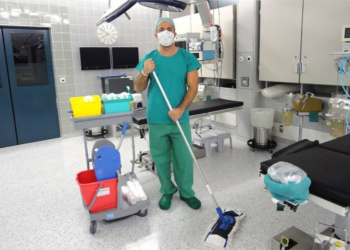Pests can be a huge nuisance in any garden or agricultural setting. Whether they’re moths that ruin crops, wasps that build nests in homes, or beetles that eat leaves, pests can cause a lot of damage. Fortunately, there are ways to protect your surroundings from these pests. In this blog post, we outline several methods that you can use to keep pests at bay. From using pesticides to using natural remedies, there is a method for everyone.
Methods to Protect Surroundings from Pests
There are many ways to protect your surroundings from pests. Some methods are more effective than others, but all of them work to some degree. Here are four common methods for protecting your plants and garden from pests:
1. Use a barrier garden. A barrier garden is a layout in your garden that separates different growth types (plants, shrubs, etc.), creating a cleaner environment for insects and other pests that might want to feed on the plants in one area and leave the clean plants in another. This is an effective way to protect plants against aphids, thrips, slugs, and other pests.
2. Install outdoor insect traps. Outdoor insect traps work by trapping flying insects so they can be identified and eliminated. They come in various styles (some with lights), so you can place them anywhere in your garden that you think might be infested with pests.
3. Use natural deterrents like garlic or mint oil. Garlic and mint oils repel many types of bugs, including mosquitoes and beetles, so they can be used as natural deterrents around areas where there are likely to be high concentrations of these pests (such as gardens or homes). You will need to test these oils before using them around sensitive plants or areas, however.
4. Use beneficial bugs to control pests. Beneficial bugs are predatory insects that eat other types of insects; they’re often used as part of Integrated Pest Management (IPM) programs to help control
How to Apply Pesticides
There are a few ways to protect your surroundings from pests.
One way is to use pesticides. Pesticides can be found in many forms, including liquids, dusts, granules, or sprays.
To use pesticides effectively, you need to understand how they work and what kind of pests they are best suited for.

Liquid pesticides are usually applied as a garden spray. You mix the pesticide with water and pour it into the spray tank or hand gun. In some cases, you may also add propellants (such as nitrogen) to make the pesticide shoot farther and faster. To apply liquid pesticides effectively:
-Read the product label carefully before using it
-Follow all safety instructions included with the product
-Avoid getting chemicals on your skin or eyes
-Keep children away from areas where pesticides are being used
Types of Pesticides
There are many types of pesticides and each has its own benefits and drawbacks. Some pesticides are contact, others are systemic. Contact pesticides are applied directly to the pest. Systemic pesticides go through the plant and eventually reach the pests.
Contact pesticides:
The most common type of contact pesticide is an insecticide. Insecticides work by poisoning or suffocating the pests. They are usually applied as liquid or mist sprays, or as pellets that can be spread on the ground. Contact poisons can be effective against small insects, but will not kill larger pests such as mosquitoes or spider mites.
There are two main types of insecticides: pyrethroid and organophosphate. Pyrethroid insecticides work by destroying the central nervous system of pests, while organophosphate insecticides disrupt their respiratory systems. Both types of insecticides have been linked to health problems in people, including death, so they should only be used when necessary and with caution.
Organic compounds such as neem oil can also act as contact pesticides by deterring bugs from landing on plants. Neem oil is a natural product that has been used for centuries to control pests in gardens and agricultural areas around the world. It has a low toxicity to humans, pets and wildlife, making it a safe choice for use around homes and gardens.
When to Spray for Pests
Certain pests, like ants and cockroaches, will move around in search of food. This means that they are constantly coming into contact with surfaces where other pests live or feed. If you want to protect your home from these pests, it’s important to get in touch with pest control Point Cook team.
To determine when to spray for pests, first check weather conditions. Do not spray if there is rain forecast or if high wind speeds are expected. Insecticide products work best when the temperature is between 65 and 80 degrees Fahrenheit.
Once you know the conditions that allow for effective pest control, look at your specific problem. Pests like ants travel in colonies; if one ant is killed by insecticide, the colony may disperse and new colonies will form elsewhere. Look for signs of an infestation: nests outdoors, insects flying or crawling around indoors, trails leading from indoors to outdoors.
If you think you have an infestation, choose the appropriate pesticide and follow directions carefully. Remember to keep children and pets away while spraying pesticide products because they can be affected by their residue.
Chemical Pest Control
There are a variety of ways to protect your surroundings from pests. You can use chemicals, traps, and barriers to keep pests away. Chemical pest control can be effective if used correctly especially when it is sued by professionals such as pest control Rowville. There are many different types of chemicals available, so it is important to choose the right one for the situation.
chemical pesticides: Pesticides are a common form of chemical pest control. They kill insects by either poisoning or disabling their ability to reproduce. Pesticides can be harmful if not used properly, so always read the label and follow instructions carefully.
chemical repellents: Another type of chemical pest control is using repellents. Repellents work by making pests afraid of the smell or taste of the repellent. This will make them stay away from areas where the repellent is applied.
traps: Traps are another common form of chemical pest control. They capture insects by trapping their bodies or eggs. Once trapped, the insect can be killed or disposed of humanely.
barriers: Barriers are yet another form of chemical pest control. They use physical barriers to stop pests from entering an area or getting past a barrier into another area.
Biological Pest Control
There are many natural ways to protect your surroundings from pests. Some methods you can use include:
1. Planting a variety of plants in your garden: A diverse garden will help to attract a wide range of insects, which in turn will help to control insect populations.
2. Making sure your garden is well-maintained: Clean up any debris that accumulates over time, and water the plants regularly. This will help keep pests away and ensure the plants get the nutrients they need to grow healthy.
3. Using physical barriers to keep pests out: You can erect walls or fences around your property to keep pests out, or spray them with chemicals that will kill them off.
Conclusion
Pests can be a real pain, and it’s not uncommon for homeowners to go through endless rounds of pesticides and other pest-control measures in an attempt to rid their property of these pesky creatures. However, there are several methods you can use to protect your surroundings from pests without resorting to harmful chemicals. Try out some of these tips and see which works best for you.





